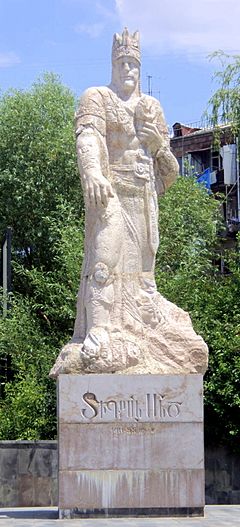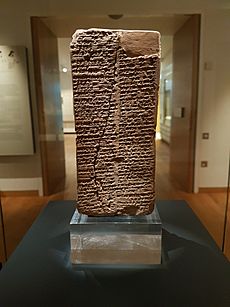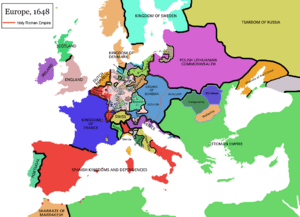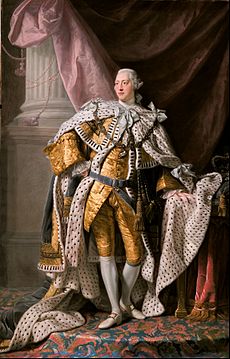Monarchy facts for kids
A monarchy is a type of government where one person, called the monarch, is the head of state for their whole life or until they step down. The monarch's power can be very limited, mostly for show (constitutional monarchy), or they can have total control (absolute monarchy). Their power might cover making laws, running the country, and even judging cases.
Often, monarchs inherit their position, meaning it passes down through their family. This creates royal families that rule for many years. However, sometimes monarchs are chosen by others (elective monarchy) or even declare themselves rulers. While not always part of a monarchy, noble families often provide the monarch and fill important roles in the government.
Monarchs can have different titles like emperor, empress, king, or queen. Monarchies can also join together, sharing the same monarch but keeping their own laws. This is why a monarch might have several titles.
Monarchies were the most common type of government until the 1900s. By then, many countries had become republics (where the people elect their leaders). Today, 43 countries still have a monarch. This includes 15 Commonwealth realms that all share King Charles III as their head of state. Most modern monarchies are constitutional monarchies. This means the monarch has special legal and ceremonial duties but usually has little to no real political power, much like a president in a parliamentary republic.
Contents
What Does "Monarchy" Mean?
The word "monarch" comes from an Ancient Greek word that means "one ruler." It was used to describe a single, powerful leader. Today, "monarchy" usually refers to a system where rulers inherit their position, as elected monarchs are quite rare.
A Look Back in Time: History of Monarchies
The idea of a single leader, like a chief or tribal king, goes back to prehistoric times. These early chiefdoms helped create the first states, like those in Mesopotamia, Ancient Egypt, and the Indus Valley civilization. In some places, these chiefdoms grew into monarchies. Some of the earliest known monarchs were Narmer, a Pharaoh of Ancient Egypt around 3100 BCE, and Enmebaragesi, a Sumerian King from Kish around 2600 BCE.
From the very beginning, some monarchs inherited their power, while others were chosen by important people. In many ancient cultures, like the Egyptians and Indians, the monarch had special religious duties and was sometimes even seen as having divine ancestry. This led to the idea of the divine right of kings, where rulers believed their power came directly from a god.
An ancient Greek thinker named Polybius saw monarchy as one of three "good" forms of government, along with aristocracy (rule by nobles) and democracy (rule by the people). He thought these were better than "bad" forms like tyranny (cruel rule by one person) or oligarchy (rule by a small group). In ancient times, a monarch was often called a "king" or "queen."
Over time, monarchy started to be seen as different from a republic, where citizens and their elected groups hold power. In ancient Rome and Athens, monarchies were even replaced by republics.
By the 1600s, the idea of monarchy faced challenges. Groups like parliaments started to gain more power. Major events like the temporary overthrow of the English monarchy in 1649, the American Revolution in 1776, and the French Revolution in 1789 further questioned the power of kings and queens.
Since then, supporting republics has been called republicanism, while supporting monarchies is called monarchism. Many countries got rid of their monarchies and became republics in the 1900s, especially after World War I and World War II.
Today, most monarchs are constitutional monarchs. They have special legal and ceremonial roles but usually have little to no political power. Some are even called "crowned republics" because they are mostly democratic, even with a monarch.
However, in some countries like Morocco, Qatar, Liechtenstein, and Thailand, the monarch still has a lot of political influence, even if there is a constitution.
What Monarchs Are Like and What They Do
Monarchies are usually about hereditary rule. This means monarchs rule for life, and their power passes to their child or another family member when they die. Most monarchs are born into a royal family and are trained from a young age for their future role.
There are different ways to decide who inherits the throne. For example, primogeniture means the oldest child becomes monarch. Historically, this often meant the oldest son. However, many countries now have "equal primogeniture," where the oldest child, whether male or female, inherits the throne.
Sometimes, if a monarch has no children, the next closest family member, like a younger sibling, becomes the monarch.
The main benefit of a hereditary monarchy is that there's always a clear leader. When one monarch dies, the next one is ready to take over immediately.
Some monarchies are not hereditary. In an elective monarchy, monarchs are chosen by a special group of people for life or a set time. Today, there are four elective monarchies: Cambodia, Malaysia, the United Arab Emirates, and the papacy (the Pope is elected).
A self-proclaimed monarchy happens when someone declares themselves monarch without any family ties to previous rulers. For example, Napoleon I of France crowned himself Emperor after being a leader of the French Republic.
Different Kinds of Monarchs
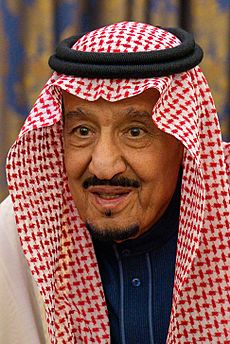
- In an absolute monarchy, the monarch has total power over the country and government. They can make laws, issue orders, and decide punishments.
- In a constitutional monarchy, the monarch's power is limited by a constitution. In most modern constitutional monarchies, the monarch is mainly a figurehead. They are a symbol of national unity but have little to no real political power. The people, through their elected representatives, hold the real power. Constitutional monarchs might have powers like granting pardons or giving out honours. Their actual power depends on tradition, public opinion, and laws.
* Semi-constitutional monarchies are somewhere in between. The monarch still has significant power, but there are also elected bodies.
- Monarchs have sometimes been closely linked to the military. In some historical cases, the military even chose or removed emperors.
Who Can Be a Monarch?
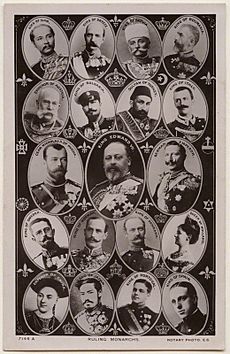
Most monarchies have only one monarch at a time. However, some countries have had two monarchs ruling together, which is called a diarchy. Ancient Sparta in Greece is an example. Today, Andorra is the only constitutional diarchy. It has two co-princes: the bishop of Urgell in Spain and the president of France. This means one of Andorra's rulers is elected by citizens of another country (France), and the other is appointed by a foreign head of state (the Pope).
In a personal union, separate countries share the same monarch but keep their own laws and governments. The fifteen Commonwealth realms, which share King Charles III, are an example of this.
A regent is someone who rules when the monarch is too young, away, or unable to rule.
A pretender is someone who claims a throne that has been abolished or is already held by someone else.
Abdication is when a monarch formally gives up their power.
Monarchs often have a special ceremony, like a coronation, to mark the start of their reign.
What Monarchs Do
Monarchy, especially absolute monarchy, has often been connected to religion. Many monarchs claimed they had the right to rule because a deity wanted them to (Divine right of kings). Some even claimed to be divine themselves. Many European monarchs were called "Defender of the Faith" and held official roles in the state religion.
In the past, many thinkers believed a balanced monarchy was the best form of government. They thought it was less likely to become a tyranny than other systems.
In Saudi Arabia, the king is the absolute monarch and also the "Custodian of the Two Holy Mosques," a very important religious title in Islam.
Monarchs can also connect different countries through personal unions, creating larger kingdoms or states.
Cool Titles Monarchs Use
Monarchs have many different titles. In Europe, common titles include emperor or empress, king or queen, grand duke or grand duchess, prince or princess, and duke or duchess. Slavic rulers used titles like knyaz and tsar (like "Caesar").
In the Islamic world, monarchs might be called caliph, padishah (emperor), sultan or sultana, shah, malik (king), or emir (prince). East Asian monarchs used titles like huángdì (emperor) or tennō (emperor). In South Asia, titles included mahārāja (high king) and raja (king). Ancient Egyptian monarchs were called pharaoh. In Ethiopia, monarchs were called nəgusä nägäst (king of kings).
Many monarchs are addressed with special phrases like "Majesty" or "Royal Highness."
Sometimes, titles are used to claim lands that the monarch doesn't actually control. Also, if a monarchy is overthrown, former monarchs might be given new, different titles.
Monarchs Who Aren't Fully in Charge
A non-sovereign monarchy is one where the monarch is under the authority of a higher power. This happened in the British colonial era, where local princes ruled but were subject to the British Empire.
Today, in countries like Botswana, South Africa, Ghana, and Uganda, ancient kingdoms and chiefdoms are protected by their country's constitution. For example, in Nigeria, many traditional rulers are legally recognized, even if they aren't in the main constitution. The Oba Deji of Akure, for instance, is chosen by a group of nobles from royal families.
How Monarchs Get Their Power: Succession
Passing Down the Crown: Hereditary Monarchies
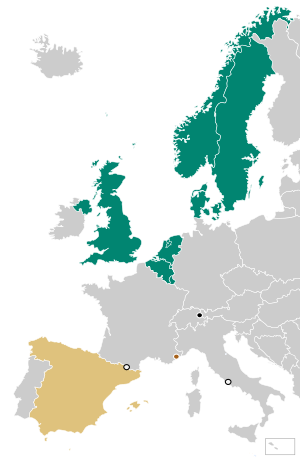
In a hereditary monarchy, the monarch's position is passed down according to specific rules, usually within one royal family. This means the next in line for the throne is usually known well in advance, making the transfer of power smooth.
Primogeniture is the most common system. It means the eldest child of the monarch is first in line. Historically, many countries used "agnatic primogeniture," where only sons could inherit, and the eldest son would come before any daughters. However, many European countries, like Sweden (in 1980), Netherlands, Norway, Belgium, Denmark, and Luxembourg, have changed to "equal primogeniture." This means the eldest child, whether male or female, inherits the throne. The United Kingdom also adopted this in 2013.
If a monarch has no children, the throne usually goes to the next closest family member, like a younger sibling.
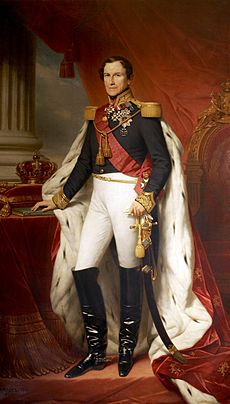
Some hereditary systems are different. In Saudi Arabia, for example, the throne traditionally passes to the monarch's next eldest brother before going to the monarch's children. However, in 2017, King Salman changed this by choosing his son as the next in line.
When Monarchs Are Chosen: Elective Monarchies
In an elective monarchy, monarchs are chosen by a special group of people for life or a set period. There is no public vote. Historical examples include the Holy Roman Emperors and the kings of the Polish-Lithuanian Commonwealth.
Today, six forms of elective monarchies exist:
- The Pope of the Roman Catholic Church (who rules Vatican City State) is elected for life by the College of Cardinals.
- The Sovereign Military Order of Malta elects its leader for life.
- In Malaysia, the federal king is chosen every five years by the hereditary rulers of nine states.
- The United Arab Emirates also chooses its federal leaders from among the emirs of its states.
- Andorra's co-princes include the President of France, who is elected by French citizens, and the Bishop of Urgell, who is appointed by the Pope.
- In New Zealand, the Maori King is chosen by a council of Maori elders. All Maori Kings have been descendants of the first King, Potatau Te Wherowhero.
Another system, used in Jordan, is when the current monarch chooses their successor, who is always a relative.
Other Ways to Become a Monarch
Sometimes, a monarchy can be established through other means, such as a coup d'état (a sudden takeover of power), or a will left by the previous monarch. Treaties between different groups can also decide who becomes monarch.
Becoming the Monarch
A monarch's power is often officially recognized through special ceremonies like coronations. During these events, they receive special items like crowns and sit on thrones. These ceremonies help make their rule seem legitimate, especially if there were questions about who should be the next ruler.
Royal Families
Succession is often about continuing a dynasty or royal family line. Sometimes, different family lines might challenge who has the rightful claim to the throne.
Problems with Succession
If there are challenges to who should be the next monarch, those who claim the throne might try to prove their right by showing special items, making treaties, or claiming they have a divine right to rule.
Monarchies Around the World Today
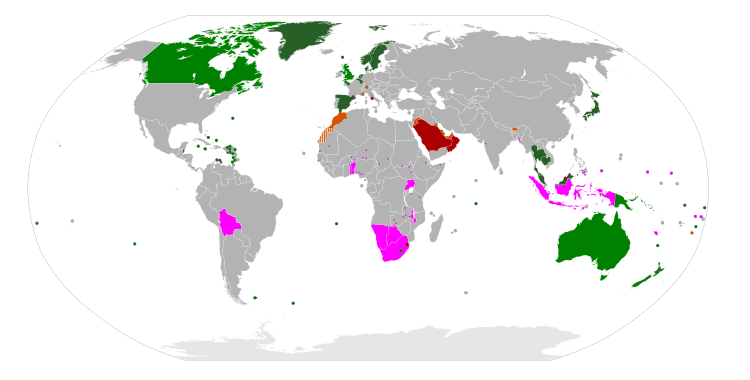
Absolute monarchies (monarch has total power) Semi-constitutional monarchies (monarch has significant power, but also elected bodies) Parliamentary monarchies (monarch has limited or ceremonial power) Commonwealth realms (parliamentary monarchies sharing King Charles III) Subnational monarchies (monarchs under a higher authority)
|
Currently, 43 countries have a monarch as their head of state. These monarchies can be grouped into different types:
Commonwealth Realms
King Charles III is the monarch of 15 separate Commonwealth realms. These countries, like Australia, Canada, and the United Kingdom, used to be part of the British Empire. They are now fully independent but still share the King as their head of state. All 15 are constitutional monarchies and full democracies, meaning the King has limited or mostly ceremonial power. The King is also the head of the Church of England, but the other 14 realms do not have an official state religion.
Other European Constitutional Monarchies
Countries like Belgium, Denmark, Luxembourg, the Netherlands, Norway, Spain, and Sweden are fully democratic. Their monarchs have a limited or mostly ceremonial role. Some of these countries have an official state church, like the Lutheran church in Norway, Sweden, and Denmark. Others, like Spain and Belgium, do not have an official state religion.
Andorra is a unique monarchy because it has two co-princes: the president of France and the bishop of Urgell from Spain. Neither of them is from Andorra. One is elected by French citizens, and the other is appointed by the Pope.
European Semi-Constitutional Monarchies
In a semi-constitutional monarchy, the monarch rules under a democratic constitution but still has a lot of power. The Principality of Liechtenstein and the Principality of Monaco are examples. For instance, the Prince of Liechtenstein can veto any law proposed by the parliament, and the parliament can veto laws the Prince tries to pass. The Prince can also appoint or remove government officials. However, the people can vote in a referendum to end the monarch's reign. The Prince of Monaco can choose the minister of state and judges. These princes have significant power in their small states, but less than absolute monarchs.
Monarchies in the Muslim World
Monarchies in the Kingdom of Bahrain, Brunei Darussalam, Jordan, Kuwait, Malaysia, Morocco, Oman, Qatar, Saudi Arabia, and the United Arab Emirates generally have much more power than European monarchs. Brunei, Oman, and Saudi Arabia are absolute monarchies. Bahrain, Kuwait, and the UAE are "mixed" monarchies, meaning they have some elected bodies, but the monarch keeps most of the power. Jordan, Malaysia, and Morocco are constitutional monarchies, but their monarchs still have more power than European ones.
East and Southeast Asian Constitutional Monarchies
The kingdoms of Bhutan, Cambodia, Thailand, and Japan are constitutional monarchies where the monarch has a limited or ceremonial role. Bhutan became a constitutional monarchy in 2008. Cambodia's monarchy was restored in 1993 after a period without it. Thailand became a constitutional monarchy over the 1900s. Japan has the world's oldest continuous monarchy, with an emperor since ancient times. After World War II, Japan greatly limited the Emperor's power, giving most of it to the elected National Diet.
Other Monarchies
Five other monarchies don't fit neatly into the above groups: the Kingdom of Tonga (Polynesia), the Kingdom of Eswatini and the Kingdom of Lesotho (Africa), and the Vatican City State (Europe). Lesotho and Tonga are constitutional monarchies. Eswatini and the Vatican City are absolute monarchies.
Eswatini is unique because it's often seen as a diarchy. The King rules alongside his mother, the Queen Mother, as dual heads of state. The King is the administrative head, while the Queen Mother is the spiritual head, though her role has become more symbolic.
The Pope is the absolute monarch of Vatican City State. He is elected by cardinals, not born into the role.
The Sovereign Military Order of Malta is a unique entity that describes itself as a "sovereign subject."
In Samoa, the head of state is chosen from four traditional paramount chiefs. While it was expected to be a hereditary role, the constitution doesn't require it, so Samoa is often considered a republic.
The ruling Kim family in North Korea (Kim Il-sung, Kim Jong-il, and Kim Jong-un) is often described as a "hereditary dictatorship" or a de facto absolute monarchy. This is because power has passed down through the family. However, North Korea is officially called the Democratic People's Republic of Korea.
Similarly, the al-Assad family in Syria (Hafez al-Assad and Bashar al-Assad) has been called a "hereditary dictatorship." After Hafez al-Assad died, the constitution was changed to allow his son Bashar to become president. Syria is officially called the Syrian Arab Republic.
Country Titles with Monarchs
- Kingdom:
 Bahrain,
Bahrain,  Belgium,
Belgium,  Bhutan,
Bhutan,  Cambodia,
Cambodia,  Denmark,
Denmark,  Eswatini,
Eswatini,  Jordan,
Jordan,  Lesotho,
Lesotho,  Morocco,
Morocco,  Netherlands,
Netherlands,  Norway,
Norway,  Saudi Arabia,
Saudi Arabia,  Spain,
Spain,  Sweden,
Sweden,  Thailand,
Thailand,  Tonga,
Tonga,  United Kingdom
United Kingdom - State:
 Kuwait,
Kuwait,  Qatar,
Qatar,  Vatican City
Vatican City - Principality:
 Andorra,
Andorra,  Liechtenstein,
Liechtenstein,  Monaco
Monaco - Federation:
 Saint Kitts and Nevis
Saint Kitts and Nevis - Commonwealth:
 Australia,
Australia,  Bahamas
Bahamas - Sultanate:
 Oman
Oman - Nation:
 Brunei Darussalam
Brunei Darussalam - Grand Duchy:
 Luxembourg
Luxembourg - Independent State:
 Papua New Guinea
Papua New Guinea - Emirate:
 United Arab Emirates
United Arab Emirates - No special title:
 Antigua and Barbuda,
Antigua and Barbuda,  Belize,
Belize,  Canada,
Canada,  Grenada,
Grenada,  Jamaica,
Jamaica,  Japan,
Japan,  Malaysia,
Malaysia,  New Zealand,
New Zealand,  Saint Lucia,
Saint Lucia,  Saint Vincent and the Grenadines,
Saint Vincent and the Grenadines,  Solomon Islands,
Solomon Islands,  Tuvalu
Tuvalu
See also
 In Spanish: Monarquía para niños
In Spanish: Monarquía para niños
Images for kids
-
King Salman of Saudi Arabia is an absolute monarch.


